MNG81001 Assessment: Virtual Teams and Communication Report
VerifiedAdded on 2023/01/18
|7
|1353
|61
Report
AI Summary
This report examines the use of virtual teams in modern business communication. It begins with an introduction that highlights the increasing reliance on virtual teams and emphasizes both their positive and negative aspects. The report then delves into the usefulness of virtual teams, emphasizing cost optimization and employee satisfaction, supported by research indicating the preference for remote work and the financial benefits of reduced real estate and transportation costs. Conversely, the report addresses the disadvantages, such as potential trust issues, isolation, and communication challenges due to poor internet connectivity, referencing studies that underscore the importance of face-to-face interactions and the potential for misinterpretations. The report also highlights the strategies for mitigating these challenges, such as structured meetings and team-building activities. The report concludes by affirming the inevitability of virtual teams in today's globalized environment, emphasizing the need for organizations to adopt appropriate strategies to leverage the expertise available worldwide.
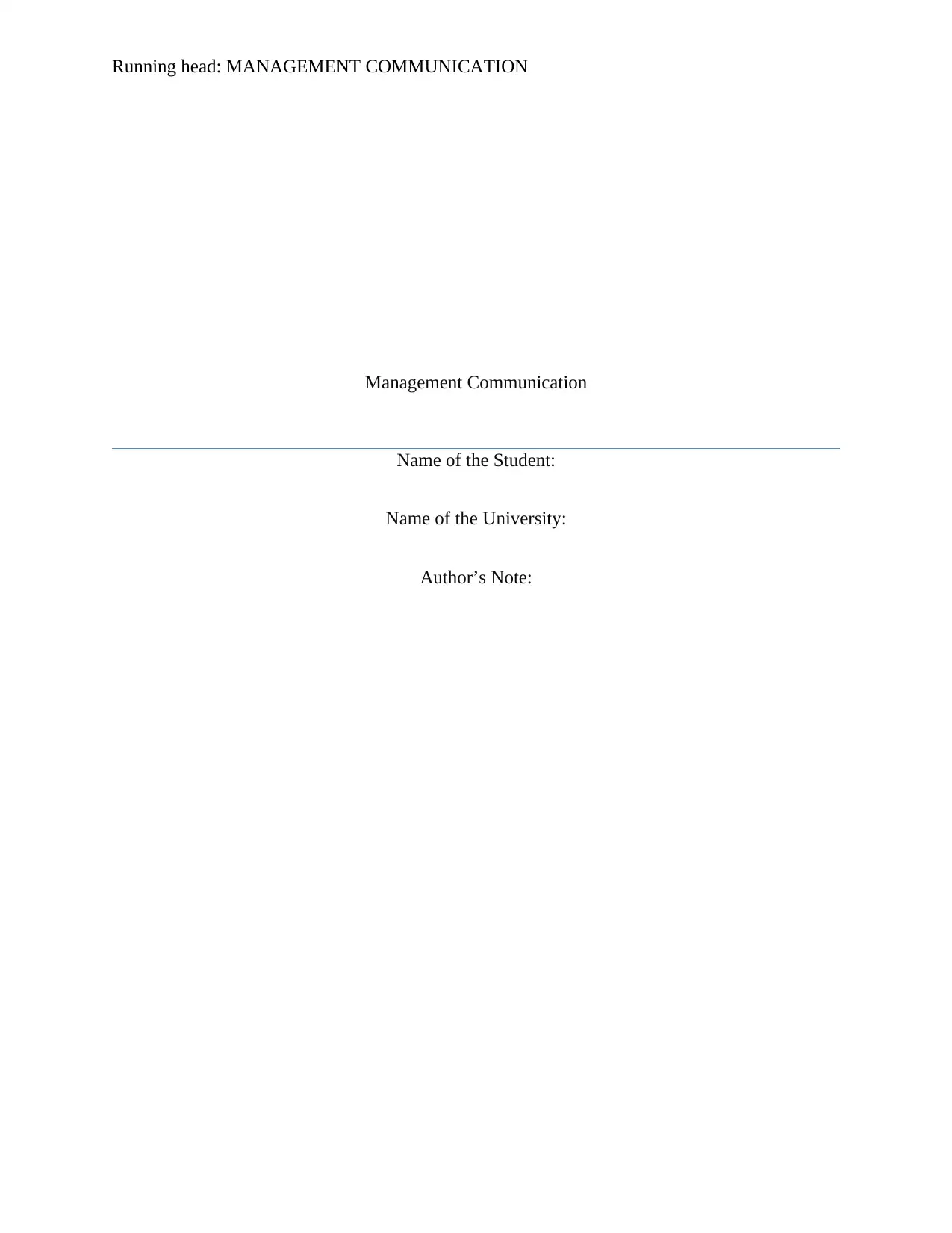
Running head: MANAGEMENT COMMUNICATION
Management Communication
Name of the Student:
Name of the University:
Author’s Note:
Management Communication
Name of the Student:
Name of the University:
Author’s Note:
Paraphrase This Document
Need a fresh take? Get an instant paraphrase of this document with our AI Paraphraser
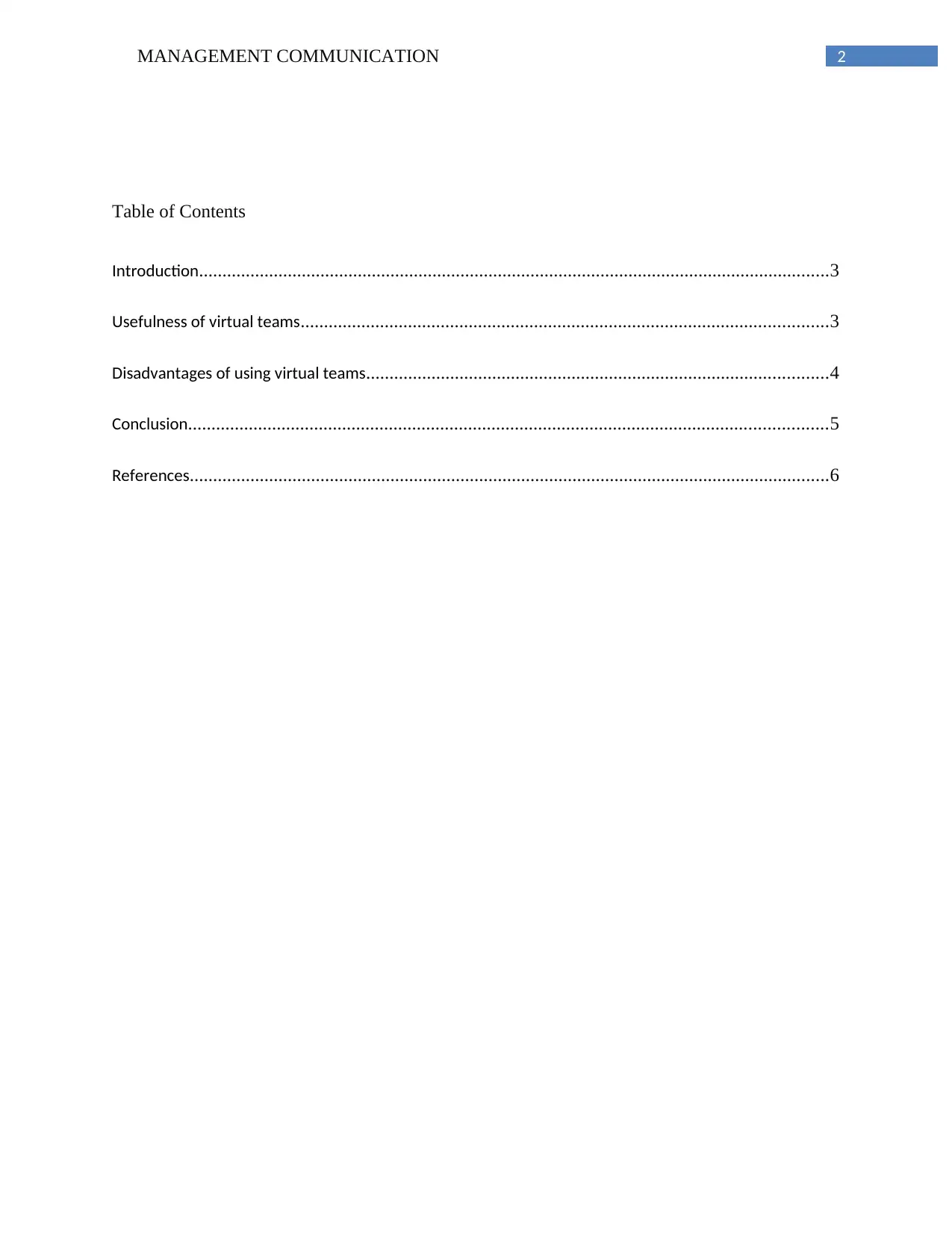
2MANAGEMENT COMMUNICATION
Table of Contents
Introduction.......................................................................................................................................3
Usefulness of virtual teams.................................................................................................................3
Disadvantages of using virtual teams...................................................................................................4
Conclusion.........................................................................................................................................5
References.........................................................................................................................................6
Table of Contents
Introduction.......................................................................................................................................3
Usefulness of virtual teams.................................................................................................................3
Disadvantages of using virtual teams...................................................................................................4
Conclusion.........................................................................................................................................5
References.........................................................................................................................................6
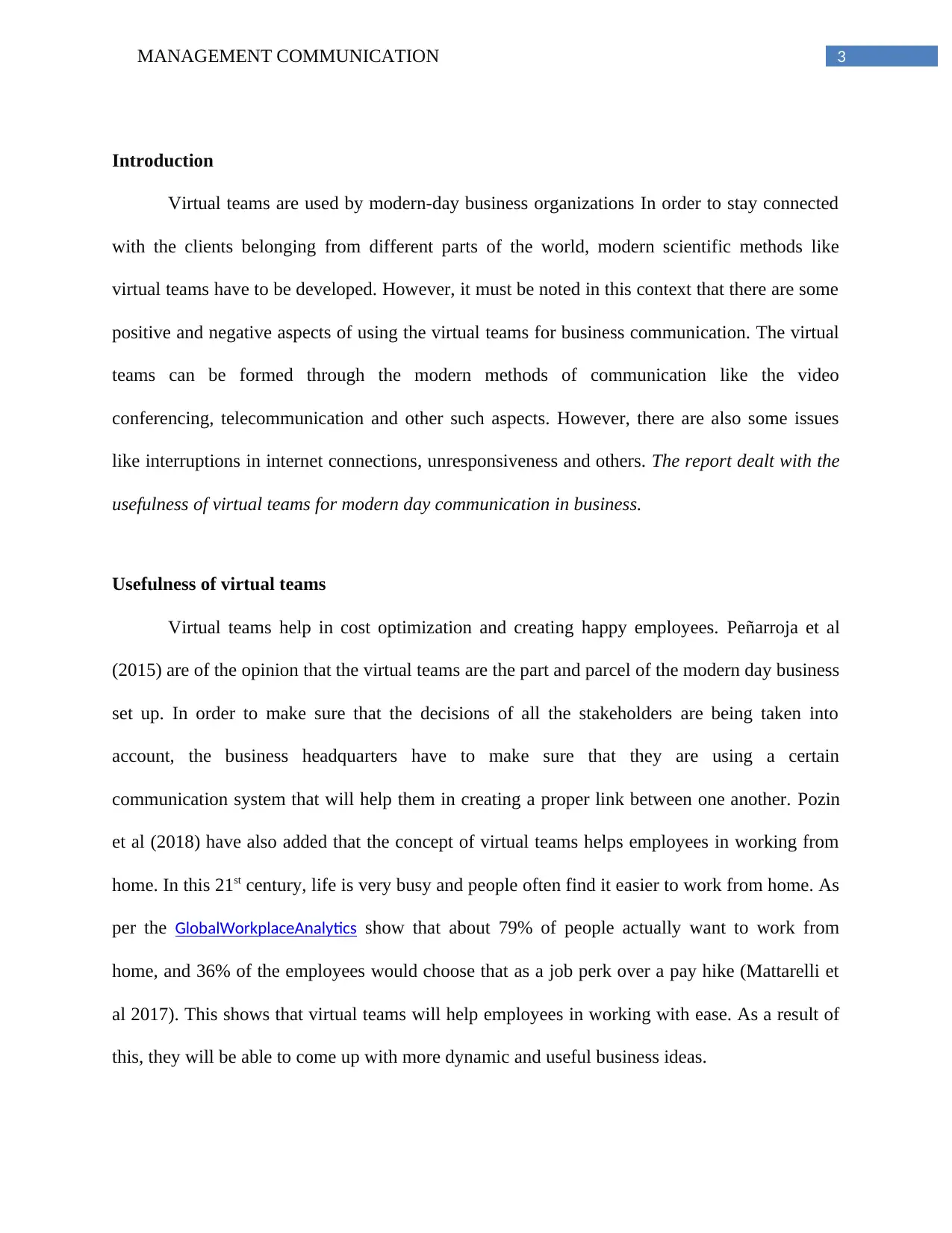
3MANAGEMENT COMMUNICATION
Introduction
Virtual teams are used by modern-day business organizations In order to stay connected
with the clients belonging from different parts of the world, modern scientific methods like
virtual teams have to be developed. However, it must be noted in this context that there are some
positive and negative aspects of using the virtual teams for business communication. The virtual
teams can be formed through the modern methods of communication like the video
conferencing, telecommunication and other such aspects. However, there are also some issues
like interruptions in internet connections, unresponsiveness and others. The report dealt with the
usefulness of virtual teams for modern day communication in business.
Usefulness of virtual teams
Virtual teams help in cost optimization and creating happy employees. Peñarroja et al
(2015) are of the opinion that the virtual teams are the part and parcel of the modern day business
set up. In order to make sure that the decisions of all the stakeholders are being taken into
account, the business headquarters have to make sure that they are using a certain
communication system that will help them in creating a proper link between one another. Pozin
et al (2018) have also added that the concept of virtual teams helps employees in working from
home. In this 21st century, life is very busy and people often find it easier to work from home. As
per the GlobalWorkplaceAnalytics show that about 79% of people actually want to work from
home, and 36% of the employees would choose that as a job perk over a pay hike (Mattarelli et
al 2017). This shows that virtual teams will help employees in working with ease. As a result of
this, they will be able to come up with more dynamic and useful business ideas.
Introduction
Virtual teams are used by modern-day business organizations In order to stay connected
with the clients belonging from different parts of the world, modern scientific methods like
virtual teams have to be developed. However, it must be noted in this context that there are some
positive and negative aspects of using the virtual teams for business communication. The virtual
teams can be formed through the modern methods of communication like the video
conferencing, telecommunication and other such aspects. However, there are also some issues
like interruptions in internet connections, unresponsiveness and others. The report dealt with the
usefulness of virtual teams for modern day communication in business.
Usefulness of virtual teams
Virtual teams help in cost optimization and creating happy employees. Peñarroja et al
(2015) are of the opinion that the virtual teams are the part and parcel of the modern day business
set up. In order to make sure that the decisions of all the stakeholders are being taken into
account, the business headquarters have to make sure that they are using a certain
communication system that will help them in creating a proper link between one another. Pozin
et al (2018) have also added that the concept of virtual teams helps employees in working from
home. In this 21st century, life is very busy and people often find it easier to work from home. As
per the GlobalWorkplaceAnalytics show that about 79% of people actually want to work from
home, and 36% of the employees would choose that as a job perk over a pay hike (Mattarelli et
al 2017). This shows that virtual teams will help employees in working with ease. As a result of
this, they will be able to come up with more dynamic and useful business ideas.
⊘ This is a preview!⊘
Do you want full access?
Subscribe today to unlock all pages.

Trusted by 1+ million students worldwide
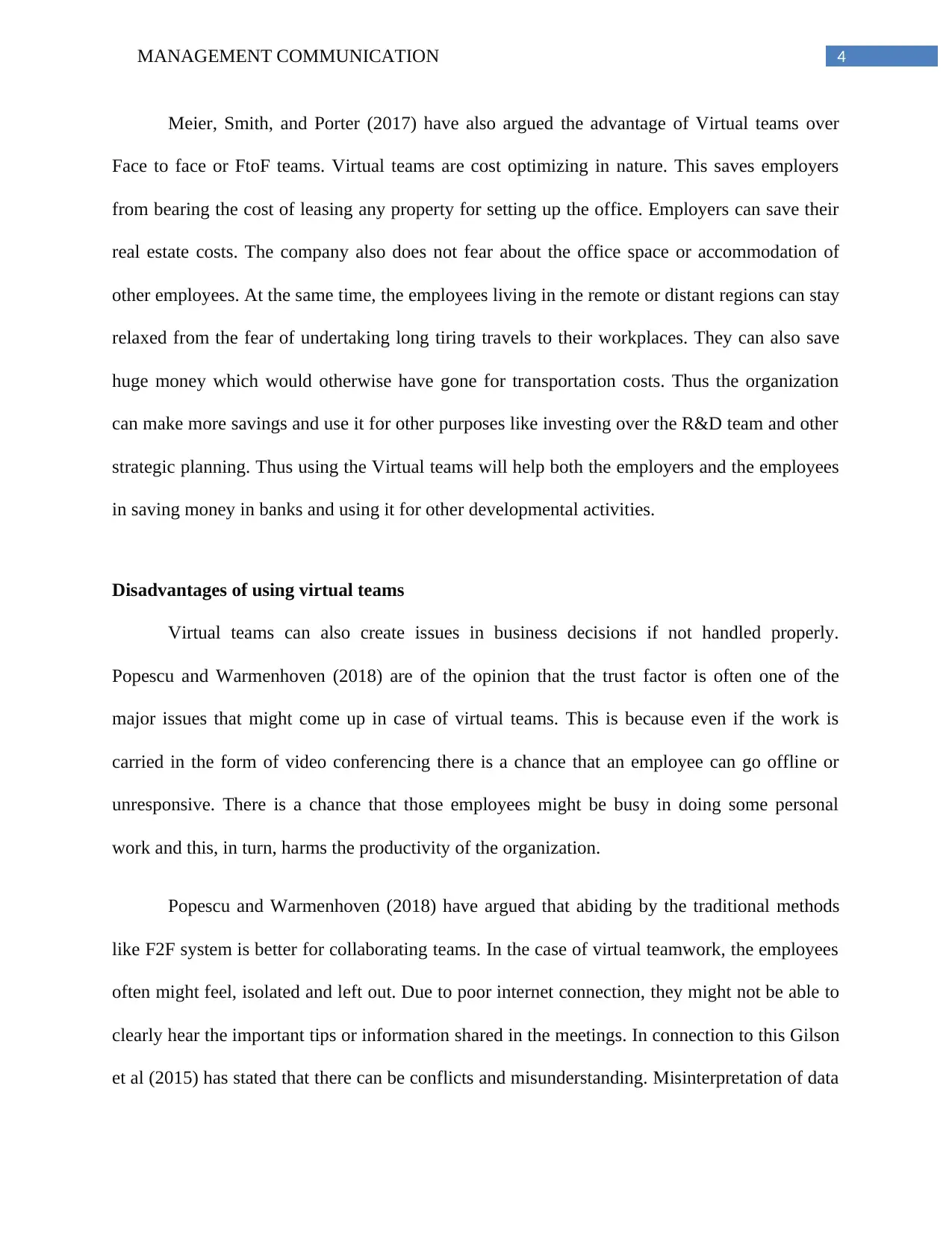
4MANAGEMENT COMMUNICATION
Meier, Smith, and Porter (2017) have also argued the advantage of Virtual teams over
Face to face or FtoF teams. Virtual teams are cost optimizing in nature. This saves employers
from bearing the cost of leasing any property for setting up the office. Employers can save their
real estate costs. The company also does not fear about the office space or accommodation of
other employees. At the same time, the employees living in the remote or distant regions can stay
relaxed from the fear of undertaking long tiring travels to their workplaces. They can also save
huge money which would otherwise have gone for transportation costs. Thus the organization
can make more savings and use it for other purposes like investing over the R&D team and other
strategic planning. Thus using the Virtual teams will help both the employers and the employees
in saving money in banks and using it for other developmental activities.
Disadvantages of using virtual teams
Virtual teams can also create issues in business decisions if not handled properly.
Popescu and Warmenhoven (2018) are of the opinion that the trust factor is often one of the
major issues that might come up in case of virtual teams. This is because even if the work is
carried in the form of video conferencing there is a chance that an employee can go offline or
unresponsive. There is a chance that those employees might be busy in doing some personal
work and this, in turn, harms the productivity of the organization.
Popescu and Warmenhoven (2018) have argued that abiding by the traditional methods
like F2F system is better for collaborating teams. In the case of virtual teamwork, the employees
often might feel, isolated and left out. Due to poor internet connection, they might not be able to
clearly hear the important tips or information shared in the meetings. In connection to this Gilson
et al (2015) has stated that there can be conflicts and misunderstanding. Misinterpretation of data
Meier, Smith, and Porter (2017) have also argued the advantage of Virtual teams over
Face to face or FtoF teams. Virtual teams are cost optimizing in nature. This saves employers
from bearing the cost of leasing any property for setting up the office. Employers can save their
real estate costs. The company also does not fear about the office space or accommodation of
other employees. At the same time, the employees living in the remote or distant regions can stay
relaxed from the fear of undertaking long tiring travels to their workplaces. They can also save
huge money which would otherwise have gone for transportation costs. Thus the organization
can make more savings and use it for other purposes like investing over the R&D team and other
strategic planning. Thus using the Virtual teams will help both the employers and the employees
in saving money in banks and using it for other developmental activities.
Disadvantages of using virtual teams
Virtual teams can also create issues in business decisions if not handled properly.
Popescu and Warmenhoven (2018) are of the opinion that the trust factor is often one of the
major issues that might come up in case of virtual teams. This is because even if the work is
carried in the form of video conferencing there is a chance that an employee can go offline or
unresponsive. There is a chance that those employees might be busy in doing some personal
work and this, in turn, harms the productivity of the organization.
Popescu and Warmenhoven (2018) have argued that abiding by the traditional methods
like F2F system is better for collaborating teams. In the case of virtual teamwork, the employees
often might feel, isolated and left out. Due to poor internet connection, they might not be able to
clearly hear the important tips or information shared in the meetings. In connection to this Gilson
et al (2015) has stated that there can be conflicts and misunderstanding. Misinterpretation of data
Paraphrase This Document
Need a fresh take? Get an instant paraphrase of this document with our AI Paraphraser
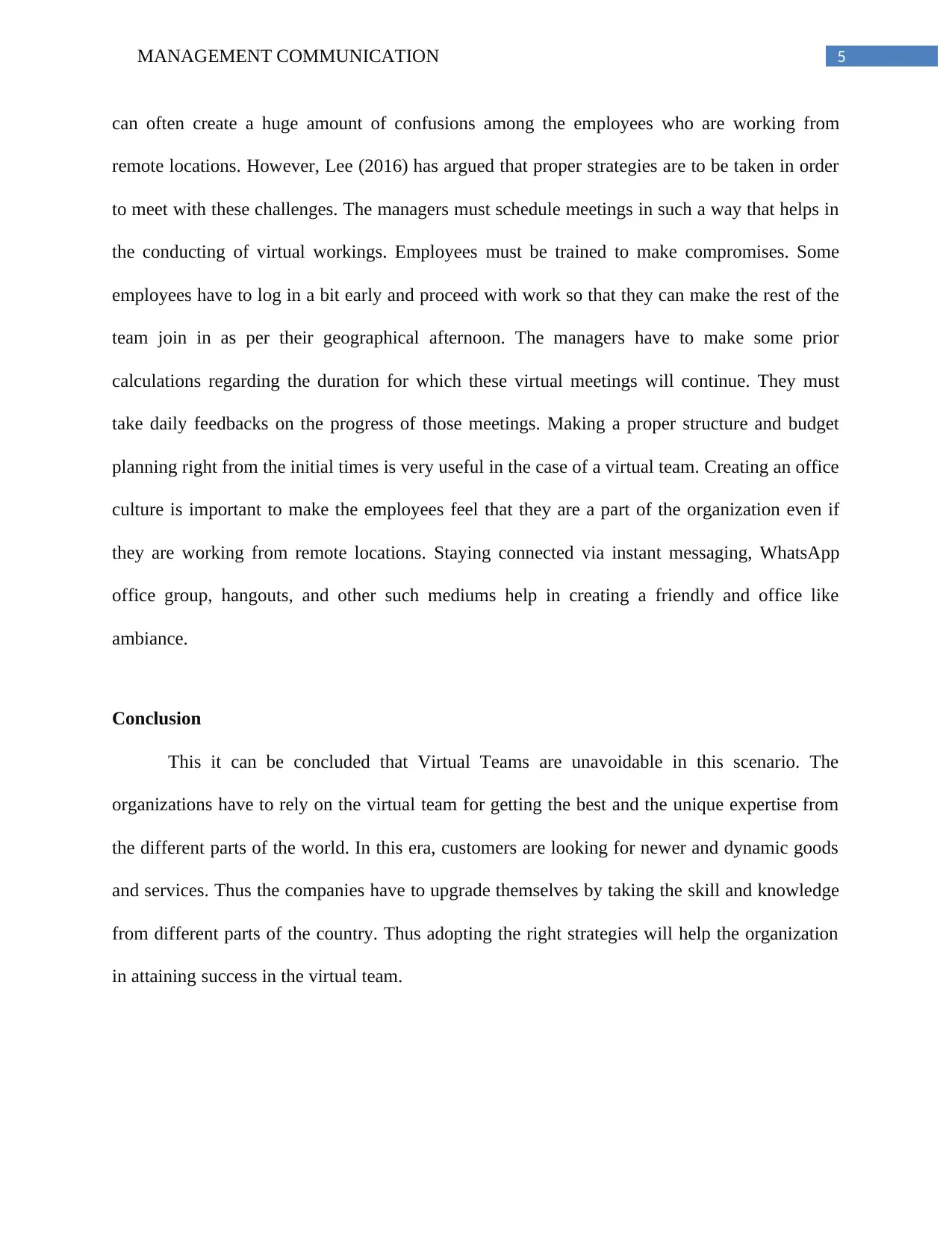
5MANAGEMENT COMMUNICATION
can often create a huge amount of confusions among the employees who are working from
remote locations. However, Lee (2016) has argued that proper strategies are to be taken in order
to meet with these challenges. The managers must schedule meetings in such a way that helps in
the conducting of virtual workings. Employees must be trained to make compromises. Some
employees have to log in a bit early and proceed with work so that they can make the rest of the
team join in as per their geographical afternoon. The managers have to make some prior
calculations regarding the duration for which these virtual meetings will continue. They must
take daily feedbacks on the progress of those meetings. Making a proper structure and budget
planning right from the initial times is very useful in the case of a virtual team. Creating an office
culture is important to make the employees feel that they are a part of the organization even if
they are working from remote locations. Staying connected via instant messaging, WhatsApp
office group, hangouts, and other such mediums help in creating a friendly and office like
ambiance.
Conclusion
This it can be concluded that Virtual Teams are unavoidable in this scenario. The
organizations have to rely on the virtual team for getting the best and the unique expertise from
the different parts of the world. In this era, customers are looking for newer and dynamic goods
and services. Thus the companies have to upgrade themselves by taking the skill and knowledge
from different parts of the country. Thus adopting the right strategies will help the organization
in attaining success in the virtual team.
can often create a huge amount of confusions among the employees who are working from
remote locations. However, Lee (2016) has argued that proper strategies are to be taken in order
to meet with these challenges. The managers must schedule meetings in such a way that helps in
the conducting of virtual workings. Employees must be trained to make compromises. Some
employees have to log in a bit early and proceed with work so that they can make the rest of the
team join in as per their geographical afternoon. The managers have to make some prior
calculations regarding the duration for which these virtual meetings will continue. They must
take daily feedbacks on the progress of those meetings. Making a proper structure and budget
planning right from the initial times is very useful in the case of a virtual team. Creating an office
culture is important to make the employees feel that they are a part of the organization even if
they are working from remote locations. Staying connected via instant messaging, WhatsApp
office group, hangouts, and other such mediums help in creating a friendly and office like
ambiance.
Conclusion
This it can be concluded that Virtual Teams are unavoidable in this scenario. The
organizations have to rely on the virtual team for getting the best and the unique expertise from
the different parts of the world. In this era, customers are looking for newer and dynamic goods
and services. Thus the companies have to upgrade themselves by taking the skill and knowledge
from different parts of the country. Thus adopting the right strategies will help the organization
in attaining success in the virtual team.
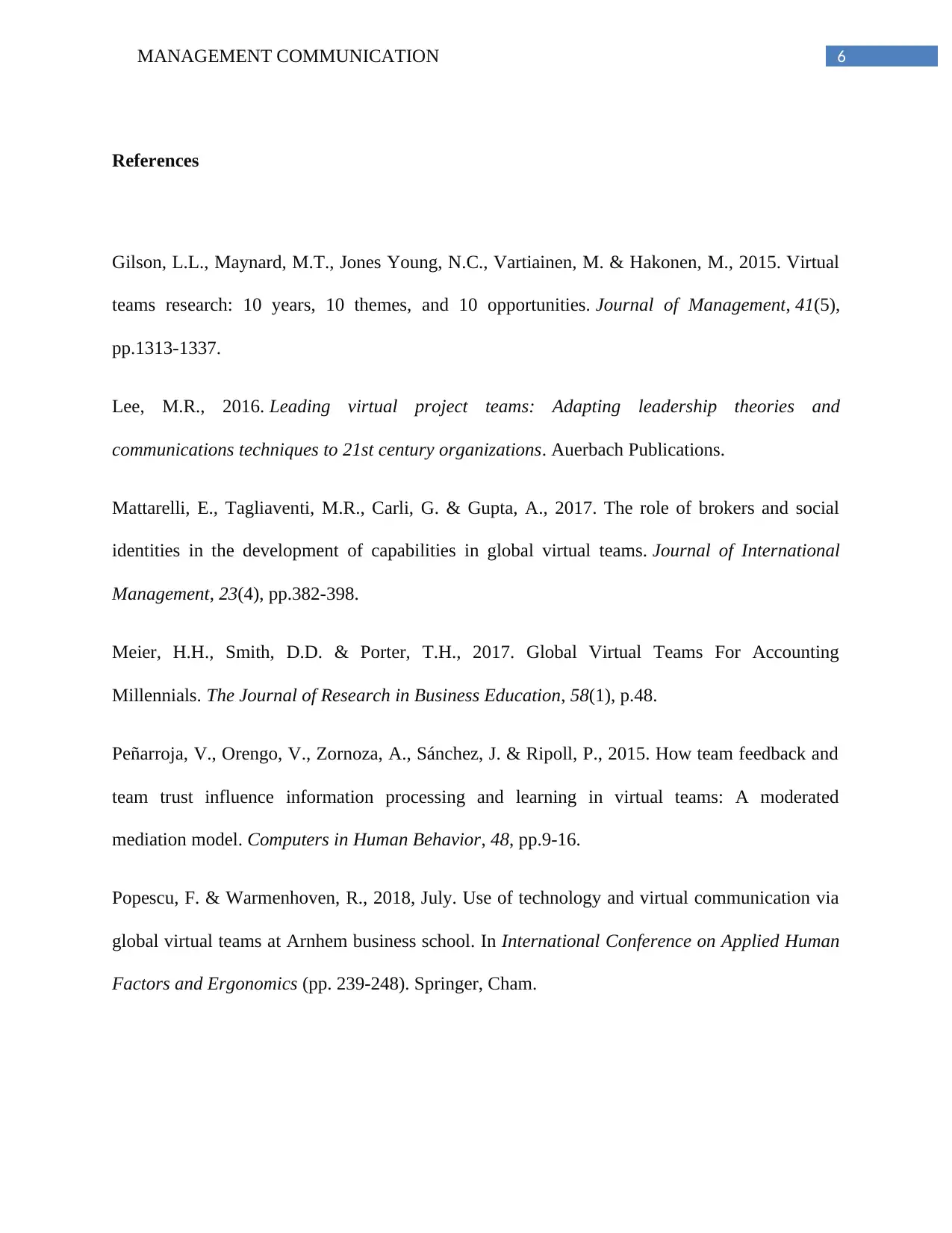
6MANAGEMENT COMMUNICATION
References
Gilson, L.L., Maynard, M.T., Jones Young, N.C., Vartiainen, M. & Hakonen, M., 2015. Virtual
teams research: 10 years, 10 themes, and 10 opportunities. Journal of Management, 41(5),
pp.1313-1337.
Lee, M.R., 2016. Leading virtual project teams: Adapting leadership theories and
communications techniques to 21st century organizations. Auerbach Publications.
Mattarelli, E., Tagliaventi, M.R., Carli, G. & Gupta, A., 2017. The role of brokers and social
identities in the development of capabilities in global virtual teams. Journal of International
Management, 23(4), pp.382-398.
Meier, H.H., Smith, D.D. & Porter, T.H., 2017. Global Virtual Teams For Accounting
Millennials. The Journal of Research in Business Education, 58(1), p.48.
Peñarroja, V., Orengo, V., Zornoza, A., Sánchez, J. & Ripoll, P., 2015. How team feedback and
team trust influence information processing and learning in virtual teams: A moderated
mediation model. Computers in Human Behavior, 48, pp.9-16.
Popescu, F. & Warmenhoven, R., 2018, July. Use of technology and virtual communication via
global virtual teams at Arnhem business school. In International Conference on Applied Human
Factors and Ergonomics (pp. 239-248). Springer, Cham.
References
Gilson, L.L., Maynard, M.T., Jones Young, N.C., Vartiainen, M. & Hakonen, M., 2015. Virtual
teams research: 10 years, 10 themes, and 10 opportunities. Journal of Management, 41(5),
pp.1313-1337.
Lee, M.R., 2016. Leading virtual project teams: Adapting leadership theories and
communications techniques to 21st century organizations. Auerbach Publications.
Mattarelli, E., Tagliaventi, M.R., Carli, G. & Gupta, A., 2017. The role of brokers and social
identities in the development of capabilities in global virtual teams. Journal of International
Management, 23(4), pp.382-398.
Meier, H.H., Smith, D.D. & Porter, T.H., 2017. Global Virtual Teams For Accounting
Millennials. The Journal of Research in Business Education, 58(1), p.48.
Peñarroja, V., Orengo, V., Zornoza, A., Sánchez, J. & Ripoll, P., 2015. How team feedback and
team trust influence information processing and learning in virtual teams: A moderated
mediation model. Computers in Human Behavior, 48, pp.9-16.
Popescu, F. & Warmenhoven, R., 2018, July. Use of technology and virtual communication via
global virtual teams at Arnhem business school. In International Conference on Applied Human
Factors and Ergonomics (pp. 239-248). Springer, Cham.
⊘ This is a preview!⊘
Do you want full access?
Subscribe today to unlock all pages.

Trusted by 1+ million students worldwide
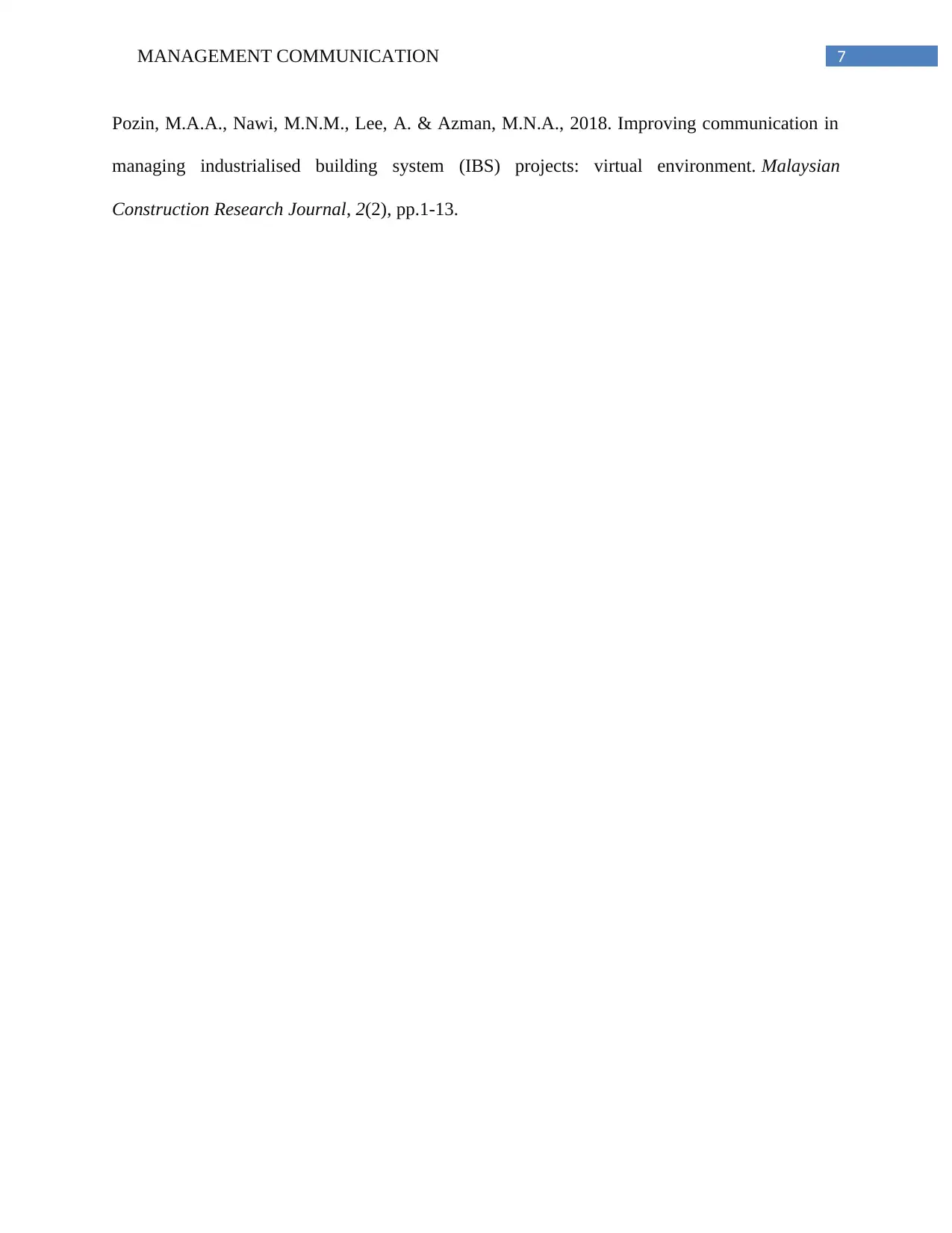
7MANAGEMENT COMMUNICATION
Pozin, M.A.A., Nawi, M.N.M., Lee, A. & Azman, M.N.A., 2018. Improving communication in
managing industrialised building system (IBS) projects: virtual environment. Malaysian
Construction Research Journal, 2(2), pp.1-13.
Pozin, M.A.A., Nawi, M.N.M., Lee, A. & Azman, M.N.A., 2018. Improving communication in
managing industrialised building system (IBS) projects: virtual environment. Malaysian
Construction Research Journal, 2(2), pp.1-13.
1 out of 7
Related Documents
Your All-in-One AI-Powered Toolkit for Academic Success.
+13062052269
info@desklib.com
Available 24*7 on WhatsApp / Email
![[object Object]](/_next/static/media/star-bottom.7253800d.svg)
Unlock your academic potential
Copyright © 2020–2025 A2Z Services. All Rights Reserved. Developed and managed by ZUCOL.





